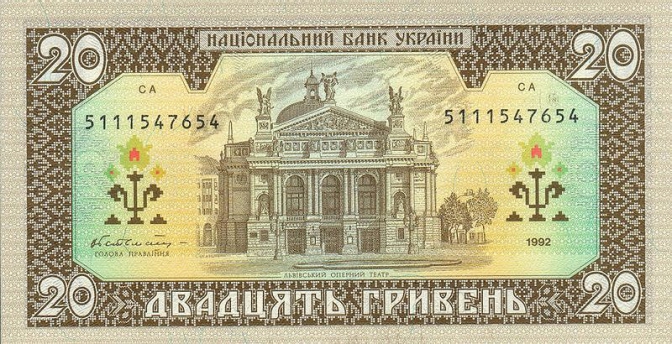
On Monday, October 4, there was a 121 birthday of Lviv National Academic Theatre of Opera and Ballet named after Solomiia Krushelnytska, or simply Lviv Opera House. It was opened in 1900 with a premiere of lyrical-dramatic opera "Yanek" by Vladyslav Zhelenskyi, which narrates the life of Carpathian highlanders. Ukrainian tenor Oleksandr Myshuha performed the main vocal party.
The opening ceremony was attended by writer Henryk Sienkiewicz, composer Ignatius Jan Paderewski and delegations from various European theatres.
On the Lviv Opera’s birthday, we offer to recall some facts from its history and the way it has changed over the years.
On July 12, 1895, the magistrate of Lviv announced a contest for the design of a new theatre. However, due to its strict conditions, the contest committee received only two projects until the deadline, which was set on the first day of the following year. The first prize went to the project "Ludendo monet", prepared by architect Zygmunt Gorgolevsky, the second one was given to the project "Justitia" by Jan Zavejski.
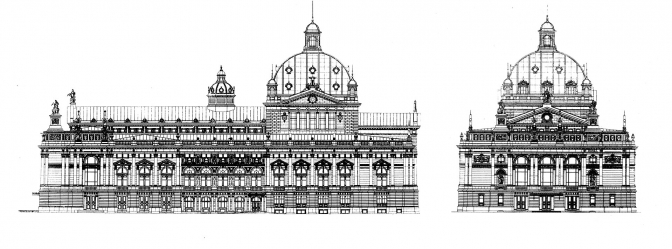
 1897
1897
Source: wikimedia.org. Author: Zygmunt Gorgolevsky
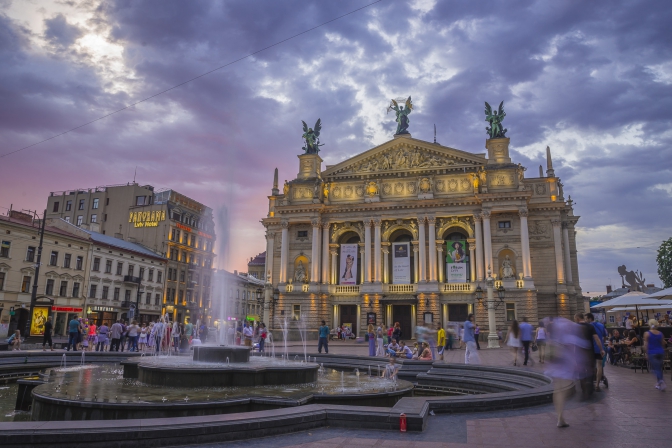
2016
Source: wikimedia.org. Author: Konstantin Brizhnichenko. License
Both architects were given extra time to finalize their designs until April 30, 1896. Finally, Zygmunt Gorgolevsky, then director of the Lviv Higher School of Arts and Crafts, became the winner. Following his designs, many elements of the exterior and interior decoration of the theatre building were made later. In 1901, the architect was awarded the Order of the Iron Crown of the 3rd class for this project. He implemented it with the help of his assistant - architect Jan Noworita.
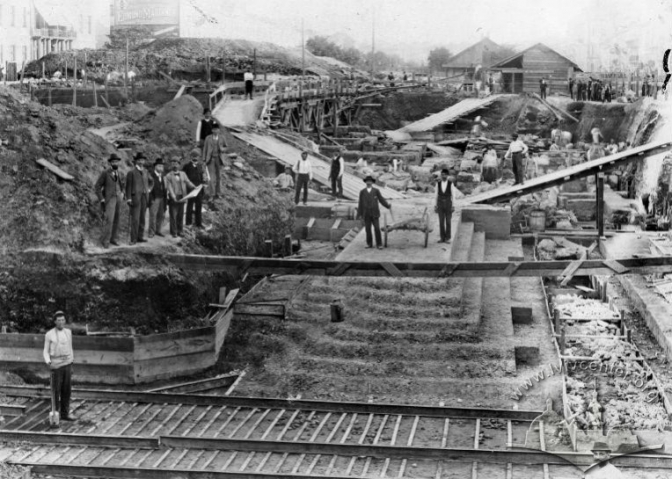
The construction of the Big Theater, one of the most beautiful buildings in the city, cost 2,500,000 crowns, or $ 500,000. After its construction, the Golukhovsky Square as such ceased to exist - the building took up the entire area, the neighbouring houses were restored, flower beds in front of the theatre were arranged. The theatre building was visible from afar, from the beginning of the Hetman's Walls on the sq. Mariatska, and it closed the ‘avenue du teatre’. The building area was 3,000 square meters
Publisher: “Center of Europe” Publishing House, Lviv
Date: 1895-1900
Collection: Lviv Historical Museum, Fm 4994
Source: lvivcenter 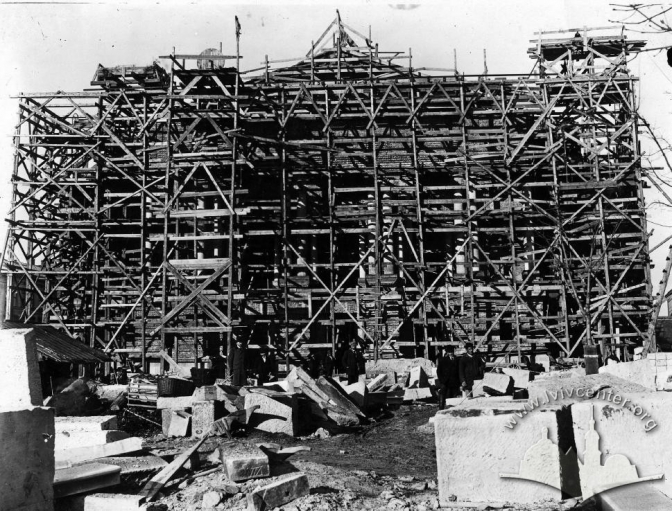
Publisher: “Center of Europe” Publishing House, Lviv
Date: 1895-1898
Collection: Lviv Historical Museum, LMH, Fm 4998
Source: lvivcenter
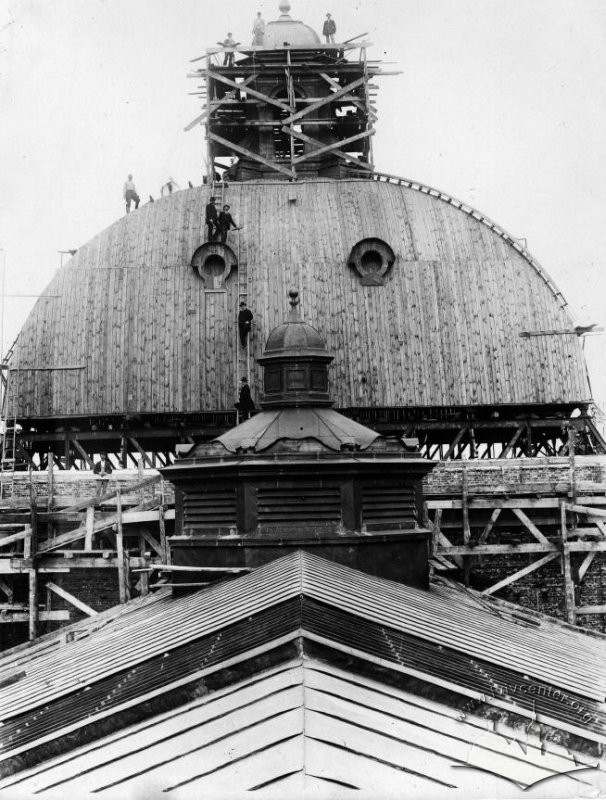
Publisher: “Center of Europe” Publishing House, Lviv
Date: 1895-1899
Collection: Lviv Historical Museum, LMH, Fm 5002
Source: lvivcenter
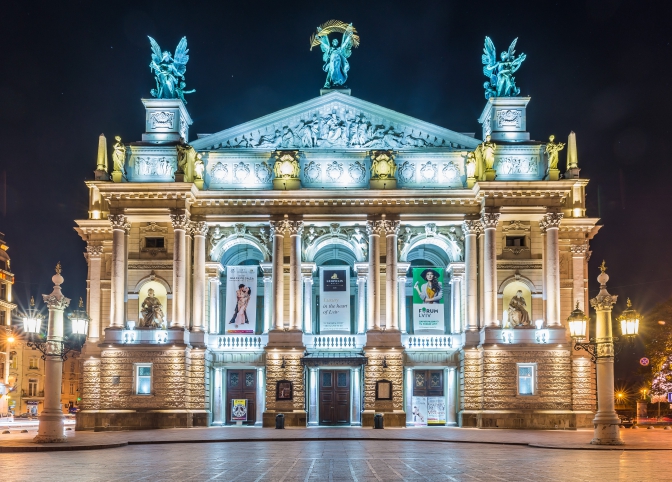
2016.
Source: wikimedia.org. Author: Konstantin Brizhnichenko. License
The theater was built during 1897-1900. To lay the foundations of the future building, the architect proposed to change the course of Poltva, which then flowed under the street from the current Maria Zankovetska Theatre and under sq. Rizni.

1900. Source: polona.pl
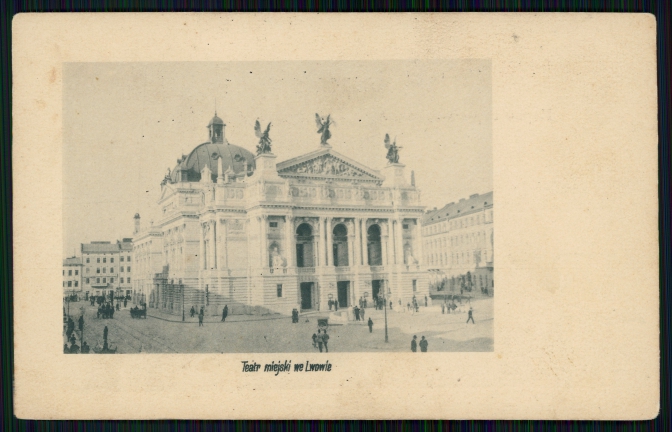
Until 1906. Source: polona.pl
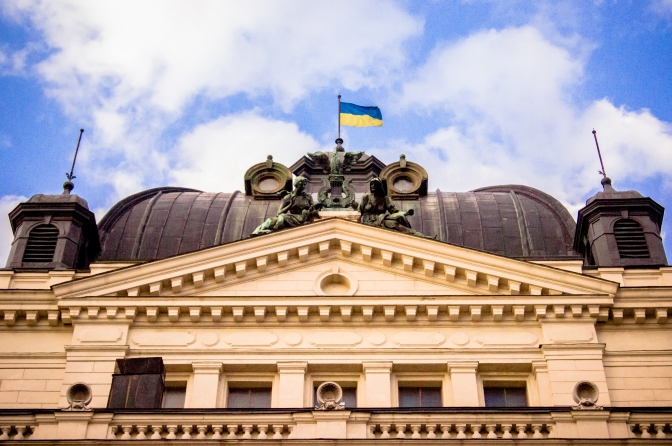
2016.
Source: wikimedia.org. Author: LR Photography. License
All construction works were supervised by the Theater Construction Committee, headed by the city president Godzimierz Malakhovsky. It also consisted of Lviv's vice presidents, Michal Michalski and Stanisław Tsiukhcinski, who visited the construction area daily; members of the City Council were also engaged: architects and builders Andrzej Golomb, Józef Kajetan Janowski, Vincent Rawski, professors of the Polytechnic Roman Dzeslevski and Bronislaw Pavelski; lawyers Edward Lilien and Alexander Mariansky, university professor Ludwig Rydiger, doctor Edward Stroinovsky. Among the members of the Committee were also Zygmunt Gorgolewski (as artistic and technical director of the construction works), director of the city construction department Juliusz Hochberger, magistrate adviser Boleslaw Ostrowski, city engineer Matei Cherny, delegates of the “krayovy” department (the executive body of the Galician regional parliament) Tadei Romanovych and Vladyslav Lozynskyi, a known historian and art collector.
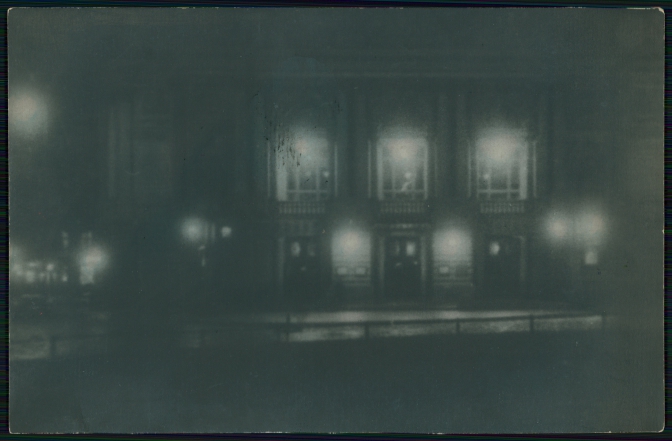
1934. Source: polona.pl
The cycle of construction works, which consisted of earth, concrete, masonry and stonemasonry stages, was executed by the architectural and construction union of Ivan Levynskyi and Józef Sosnowski.
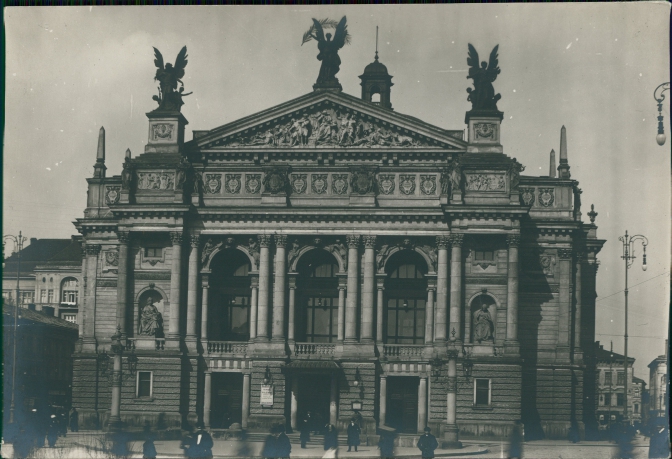
1913. Source: polona.pl 
1920. Source: polona.pl
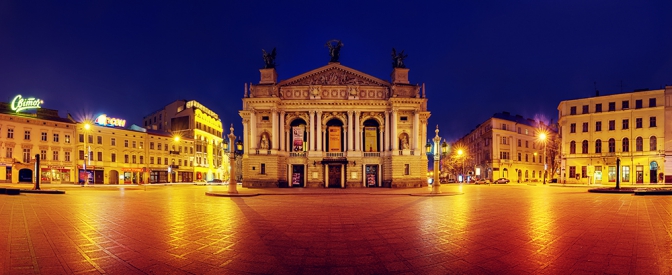
2013. Source: wikimedia.org. Author: Mykhaylo Kozelko. License
Earthworks began on June 5, 1897. A pit with a volume of 16,500 cubic meters was dug manually. During these works, the builders discovered the foundation of old defensive walls and the remains of oak piles, which used to strengthen the banks of Poltva river. This foundation, which was, apparently, a part of a bastion built in 1703 to protect the northwest corner of the Low Castle, crossed the pit diagonally.
On August 21, 1897, the concreting of the strip foundation under the future theatre began, which was accepted by a special theatre commission chaired by Gwalbert Zembitsky, consisting of the members of the Polytechnic Society. The asphalt waterproofing was made by the owner of the asphalt and roofing material factory Stanislav Sheliga Lyshkevych. 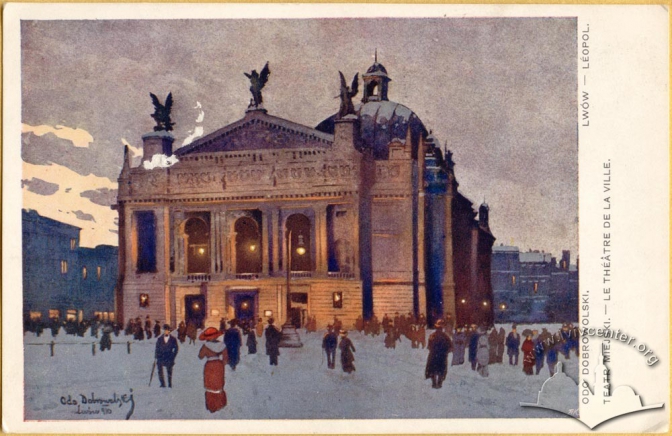
The postcard shows a view of the evening Opera House by Odo Dobrowolsky, dated 1910. In the foreground of the picture, you can see people walking in front of the Opera House, which was built in 1896-1900 by architect Zygmunt Gorgolevsky.
Creator: Odo Dobrovolsky
Publisher: Leon Propst, Lviv
Date: 1910
Collection: Museum of Art of the Ancient Ukrainian Book LGM, х Arch-493
Source: lvivcenter 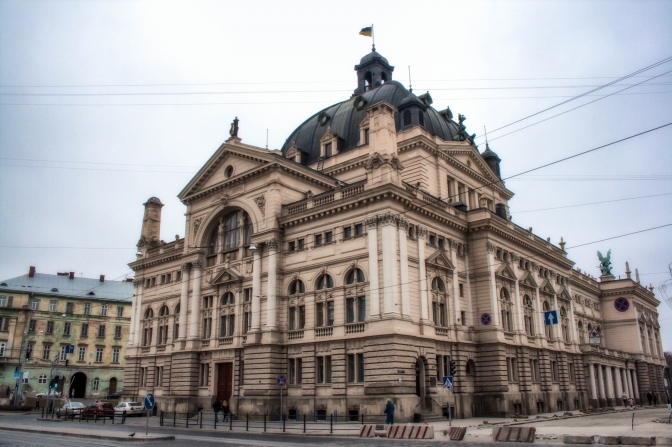
2011
Source: wikimedia.org. Author: Zoryana. License Carpentry works were performed by Krykevych's firm and the Vchelyak brothers, painting - by Pridle and Kachorovsky, glasswork - by Kupfer and Glazer, a tinsmith by Henryk Bogdanovich, and blacksmith and locksmith by Gottlieb and Svoboda firm. The metal structures of the roof and the stage were supplied by the Machine and Wagon Factory in Sianok, and the electric lighting was supplied by the German company Siemens and Galske. The ventilation of the Opera House was performed by Johannes Haas from Vienna in association with the Lviv resident Vladislav Niemeksha (1862–1905). Fresh air came to the theatre premises from a nearby kiosk (near the side facade of the old Stanislav Skarbko Theater - now, the Maria Zankovetskaya Theater).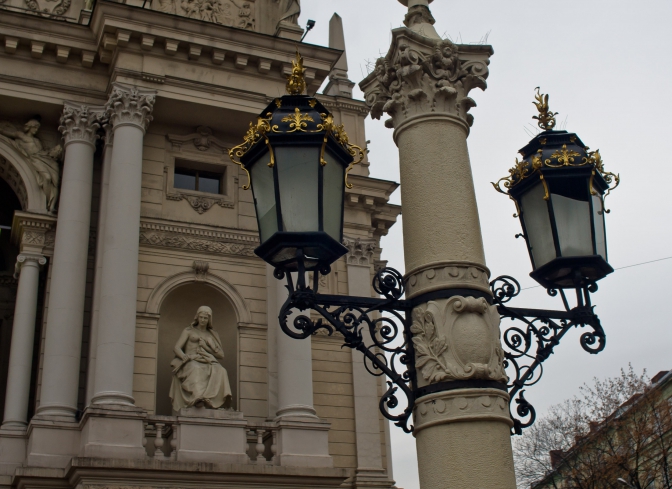
2013
Source: wikimedia.org. Author: Vladimir Kud. License
In the kiosk, built in the shape of a rotunda, the air was cooled, cleaned and then fed to the auditorium through a system of special holes in the floor. The used air was removed through a series of vents located under the edges and in the four corners of the ceiling, covered with a decorated lattice. This lattice was made according to the sketches of the theatre’s author, architect Zygmunt Gorgolewski. The air was then vented through four ventilation shafts disguised as decorative lanterns at the corners of the theatre’s dome.
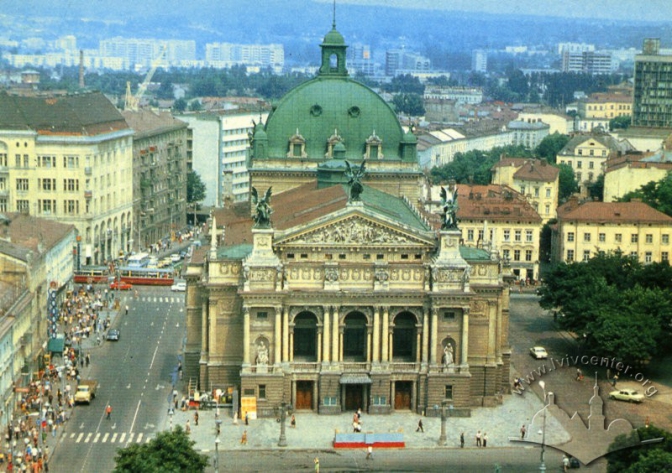
State Academic Opera and Ballet Theater named after Ivan Franko
On the right hand in the background, you can see construction works on the st. 700th anniversary of Lviv. On the site of a huge outdoor market at the back of the theatre (where in the postwar period you could buy everything from tiny stones to lighters or paintings by famous Western European artists) the largest at that time hotel "Lviv" was built in 1965.
Creator: V. Pylypyuk
Publisher: Soviet Ukraine Publishing House, Kyiv
Date: 1950-1980
Collection: Center for Urban History of Central and Eastern Europe
Source: lvivcenter
The grand opening of the theatre took place on October 4, 1900. Soon, the ground under the theatre began to sag, even more intensely than the designers had anticipated, so cracks began to appear on the walls of the building. In July 1903, Zygmunt Gorgolevsky died suddenly of paralysis of the heart’s aorta. 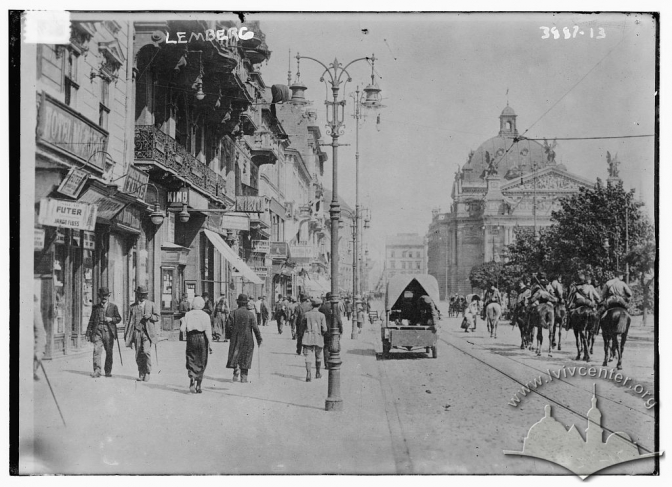
Karl Ludwig Street (now the odd-numbered side of Liberty Avenue) was recorded during the WWI Russian occupation of the city (September 3, 1914 - June 22, 1915). This is evidenced by the presence of the Cossack horsemen travelling in the Opera House direction. The street had a tram rail, which currently doesn’t exist anymore. In 1914, trams KD (main station-industrial school), HG (from "Vienna" cafe to Zhovkva slingshot and Gavrylivka), HZ (from "Vienna" cafe to Zamarstynivska slingshot) ran here.
Publisher: Library of Congress, Washington
Date: 1914 - 1915, the First World War
Collection: Library of Congress, Washington, DC, LC-DIG-ggbain-22020
Source: lvivcenter
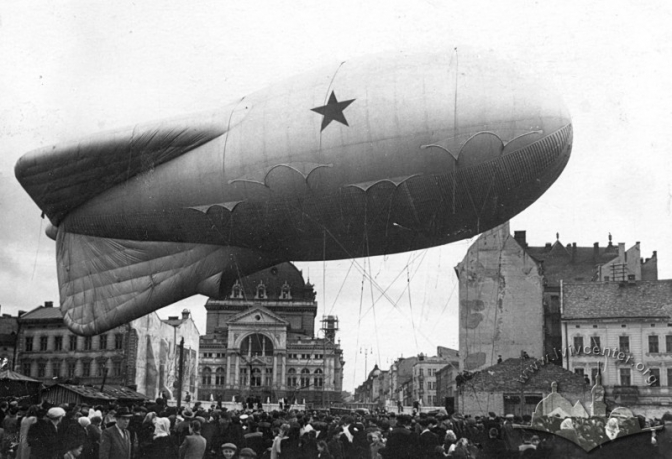
The picture shows the post-war market on Zernova Square - a flea market that took up space from the Opera House to the bridge on Peltevna street, now Chornovola Avenue. The bazaar operated almost around the clock, and right in this area among a large concentration of sellers, buyers and pickpockets, people could buy scarce goods. The best selling product was "bimber" - moonshine expelled from the ingredients which weren’t known for sure to anyone (from the memoirs of Vladimir Rumyantsev)
“Back in the early 50s, in Lviv, during the public holidays (I don’t remember whether on May 1, or November 7, or maybe both), the"Airship" was raised over the city - in fact, it was an air defence balloon. It was lifted from the square, where the Lviv Hotel is now, and the ropes were attached to the trucks. The balloon was probably 60 meters high, it had a huge flag with profiles of "the main Marxists of the planet", and at night this construction was illuminated by searchlights from the High Castle and the Opera" (from the memoirs of Yurii Skoblenko).
Date: 1947
Collection: Vladimir Rumyantsev
Source: lvivcenter
A high artistic value is present in the monumental parade curtain of the stage with a picturesque allegorical composition "Parnassus", which was specially ordered for the theatre by the famous artist of the academic school Henryk Semiradsky, who lived in Rome at that time. The artist did not have time to fulfil the order before the theatre’s opening, so the curtain arrived in Lviv on October 16 and was first shown to the audience on January 13, 1901. Since 1967, Semiradsky's painting is owned by the Lviv Art Gallery.
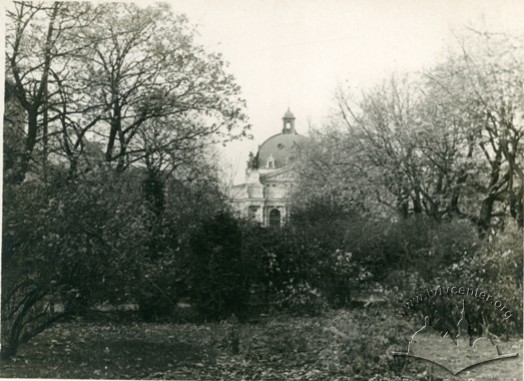
The greenery of the alley on Svobody Avenue (at that time, Lenin Avenue), through which the building of the Opera House can be seen.
Creator: Svyatoslav Vdovenko
Date: 1957-1967
Collection: Yurii Vdovenko
Source: lvivcenter
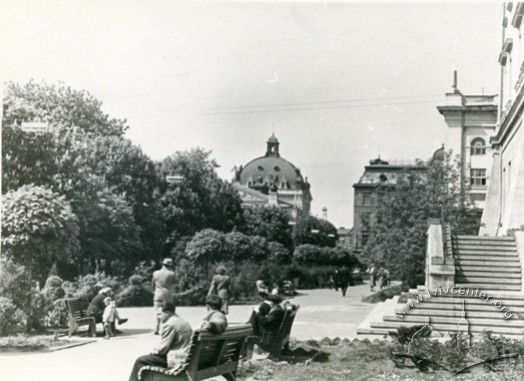
Svobody Avenue; right stairs of the Palace of Pioneers.
Creator: Svyatoslav Vdovenko
Date: May 1959
Collection: Yurii Vdovenko

Source: lvivcenter
Opera House with posters of comedy theatre tours; cars "Volga" GAZ-21 and "Victory" GAZ-20M. At the intersection of st. Lesi Ukrainky and Svobody Avenue (Lenina) there was a taxi parking, as evidenced by a special pillar on the corner.
Creator: Svyatoslav Vdovenko
Date: 1960-1965
Collection: Yurii Vdovenko
Source: lvivcenter
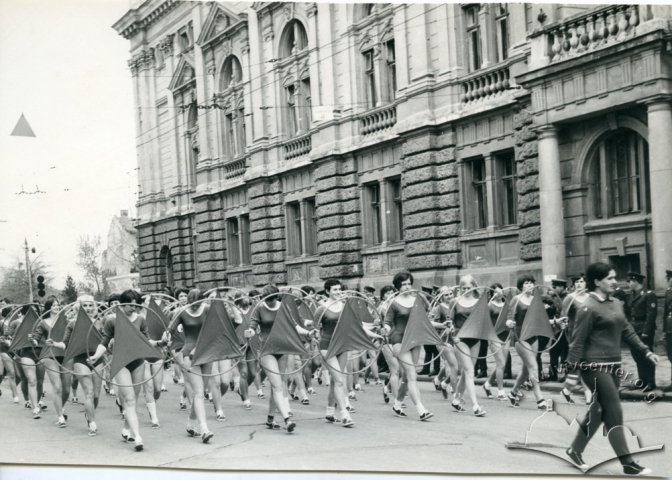
May Day demonstration on Svobody Avenue (Lenina).
Creator: Svyatoslav Vdovenko
Date: 1967-1975
Collection: Yurii Vdovenko
Source: lvivcenter
From 1978 to 1984, the theatre was reconstructed. During this period, in particular, the curtain of the stage was restored. Today, it’s carefully guarded, the modern spectator can see this curtain exclusively at the premiere performances and during the big celebrations. In 2002, a bronze sculpture of the Patron of the Theatre, a prominent Ukrainian singer Solomiya Krushelnytska, was installed in the centre of the theatre hall.
Photo on the background of the Opera House
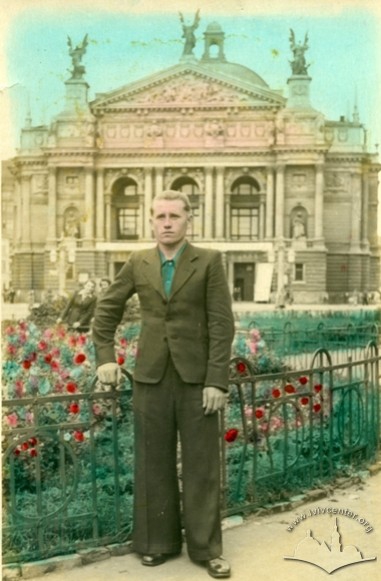
Painted black and white photo with the image of a man on the background of the Opera House.
Date: August 17, 1950
Collection: Volodymyr Rumyantsev
Source: lvivcenter
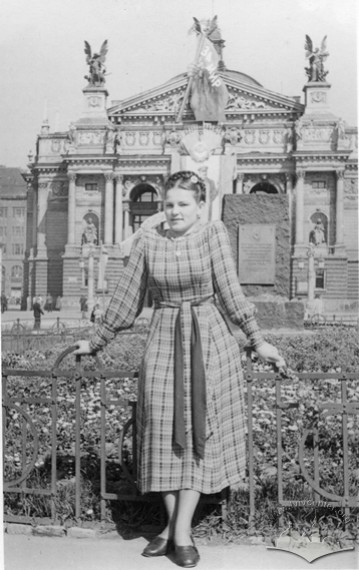
Portrait of a woman in front of the Opera House on May Day Avenue. Behind the stele, which marked the site of the monument to Vladimir Lenin.
Date: May 8, 1951
Collection: Volodymyr Rumyantsev
Source: lvivcenter
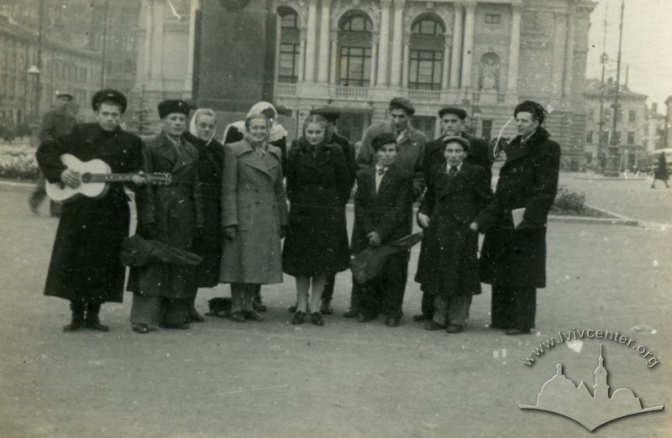
Young musicians from Olesk in Lviv in front of the Opera House.
Creator: Mykhailo Sumyk
Date: 1952-1960
Collection: Andriy Knysh
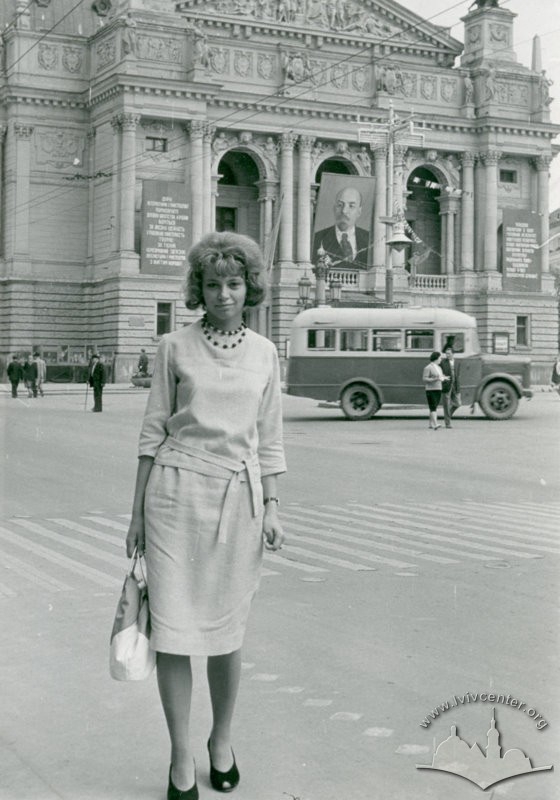
Source: lvivcenter
A woman posing for a photographer is standing on the roadway of Lenin Avenue (now Svobody Avenue). The woman is dressed in the fashion of the mid-1960s. The absence of traffic on the street may indicate that the action takes place on a public holiday, when traffic was prohibited on the main street of the city. In the background, near the Opera House decorated with visual agitation (portrait of Lenin and posters with slogans), there stays a city bus PAZ-651.
Date: 1964-1969
Collection: Yurii Zaverbnyi
Source: lvivcenter
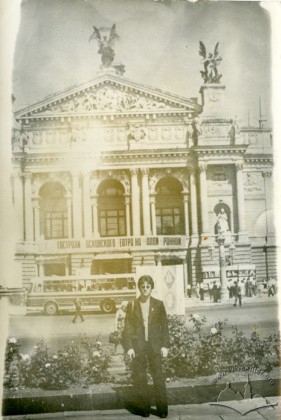
Viktor Lasayev is an engineer at the Lviv Research Radio Engineering Institute against the background of the Opera House (at the theatre, there is a poster about the tour of the Moscow Drama Theater on Malaya Bronnaya).
Date: 1973-1977
Collection: Tetiana Goshchitska
Source: lvivcenter
Opera on Ukrainian money
Reverse 20 hryvnias of the 1992 model
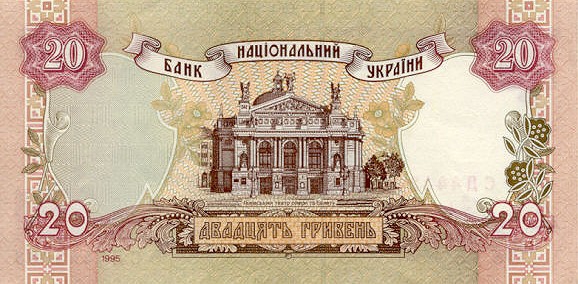
Reverse 20 hryvnias of the 1995 model
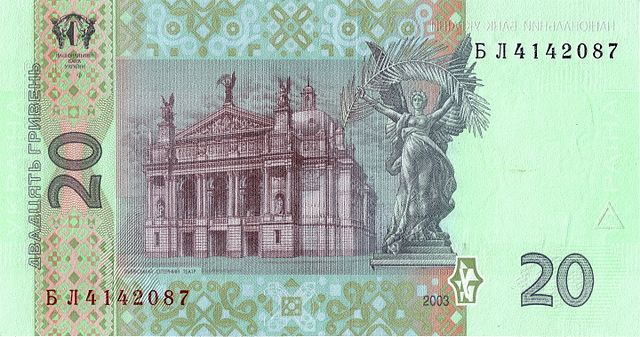
Reverse 20 hryvnias of the 2003 model
Based on materials: lvivcenter.org
Translated by Vitalii Holich
To receive our weekly email digest of stories, please follow us on Substack.



